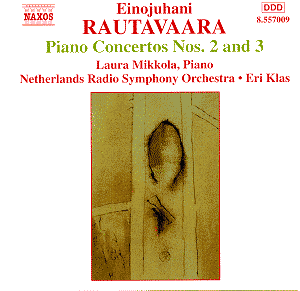Rautavaara's stylistic pilgrimage took him from
a folksy Sibelian directness of utterance through the serial 'forest'
and back out into the melodic sunlight.
Isle of Bliss is an example of
his re-emergence from the obsession with serial techniques. It
is based on a poem, 'Home of the Birds' by Aleksis Kivi (1834-72).
Kivi's poetry also inspired Sibelius. This 11 minute piece looks
back to the ecstatic melodic flow of the string writing in Cantus
Arcticus. It is an intensely romantic hybrid of Delius yet
always mobile not static and a pressing Sibelian vigour. Towards
the close Rautavaara's writing is reminiscent of Roy Harris; not
least in the luminous use of the vibraphone.
The Third Piano Concerto was written for
Ashkenazy who played and directed it with the Helsinki Phil in
1999. The first and third of the three movements are a tumultuous
ecstatic continuum, calming and animated by turns and continuing
the lucid light-suffused mood of Isle of Bliss. The central
adagio assai verges on the sentimental with a mood close
to that of John Ireland in the Ballade and the Legend
for piano and orchestra and of Bliss in the Piano Concerto.
The Second Piano Concerto, written for
Ralf Gothoni, is quite a different proposition. It is in three
continuously played movements - here tracked separately. Richard
Whitehouse, in his admirably supportive sleeve-note, tells us
that serial technique is employed but this is just as clearly
a work caught on the cusp between the avant-garde and unfiltered
melodic address to the greater audience. The central part of the
In Viaggio first movement depoys most of the arsenal of
modernistic characteristics which carry over into the Sognando
e libero (tr.6) and Uccelli sulle passioni (tr.7).
That last movement uses the ultra-modern in a deeply poetic way
reminding me John Foulds' 1930s masterpiece The Dynamic Triptych
for piano and orchestra.
Snap up this outstanding bargain. The Isle
of Bliss and the Third Concerto will present no obstacles
to appreciation. The Second Concerto requires persistence - stiffen
the sinews.
Rob Barnett
